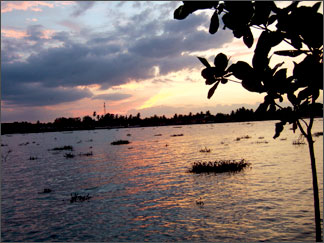|
Journey through the East:
Until the dawn of the maiden rays
by Ranga Chandrarathne
The much-awaited Eastern journey that covered most of the dispalaced
persons makeshift camps and the officials responsible for executing the
mega development plan for the East, commenced with lending our ears to
harrowing tales by refugees who have often compelled to run from one
village to another to escape the roaring flames of hostilities until
they settled down in a group of shabby make-shift tents in Trincomalee.
On a hillock near the sixth post in Koneshpuri stood the tents which
housed 107 inmates including pregnant woman and less than one-year old
babies. Their faces were woeful and vacant. Equally woeful are the
stories of how they have been uprooted from their original habitats and
escaped to Trincomalee through jungle tracks in order to avoid praying
eyes of the terrorists.
For security reasons, we escaped to Patalipuram. From there to
Sinnamveli. Thereafter to Illangamthurai Muwathurai. Then Vakarai and
Batticaloa. Finally Trincomalee', said Sita Lechchami (40).
Later, I learnt from the interpreter that Santhospuram is a coastal
village in Sampura and the name for the village was derived from a
killed LTTE cadre Santhosh. Now the village is under Sri Lankan army.
Sita belongs to a rare community of aborigines in the North East of
Sri Lanka. As their livelihood is associated with the forest, they
wanted to go back to their original habitat. Sita's family who were
uprooted from the village lot their livelihood. Although the men in the
camp joined the work parties in the road construction, they are
dependent on dry rations provided by the Government.
|

Maiden rays over the East |
When they left the village, they had to abandon their lives stocks
including chickens besides the house-hold items. It seems that their
fervent hope is to go back to their villages and to start life.
According to statistics at the District Secretary of Batticaloa,
among those who have displaced following the East Humanitarian
Operation, 104442 persons have, now, been resettled. The figure includes
31992 families. Although the remaining 11500 families are being
resettled, there are few families who could not go back to their
original habitat due to security and logistic reasons.
Sita Lechchami's village, Sampoor is fall into this category as it is
now a high security zone. Sita's dream of returning to Sampoor will, for
the time moment, remain as a dream. The hopes and fear is written over
their faces.
Another important bit of information that gathered from the
interpreter was that the attempts made to 'civilize' the aborigines by
forcing them to live in houses and to use toilets. First it was by
voluntary organisations and later by the TRO.
However, the attempts were ended up in smoke as aborigine refused to
stay in houses built for them. In a way it is a folly on the part of
those who tried to uproot aborigine from their culture and to force on
another.
The entire landscape is highly militarised and every bit of normal
life seems to be complex here. It is the people's representatives at
grass root level who listen to the people's complaints and situation has
been confounded by war and tsunami. However the major obstacle they face
is lack of allocation to solve the problems.
According to Chairman of Uppuveli Pradeshiya Sabha (Tamil National
Alliance) and Opposition Leader S. M. Senudeen (SLFP), the local
authorities have no mandate to intervene into problems faced by people.
Although most of the resettlements of Tsunami affected people have been
done, there are residual issues.
The community consisting 392 houses built at Koneshpuri has left many
unresolved issues including poorly constructed houses and allied
facilities. Dr. V. Amirdeen of the University of Peradeniya, who has
conducted a research on problems faced by people in the East of the is
of the view that new approach is needed in addressing issues given the
heterogeneous population in the East. The problems should be solved in a
manner involving all communities in the East.
This is also one aspect that can be integrated into development
programme currently undergoing in the Eastern province. Crisis in
political leadership in the East has adversely affected on the
development.
'The political crisis in the East is a major concern. It affects
every aspect of public life from development to commencing dialogue
aimed at finding a political solution. Most of them are armed while
others affected by this culture', said S. Sundaram, Chairman of the
Chamber of Commerce of Batticaloa. He is of the view that the province
needs a political leadership with a vision to develop the province and
to bring about normalcy.
People expect a political solution formulated through All Party
Conference and a solution acceptable to all communities in the province.
Although impressed by the progress achieve in the mega development plan,
people's representatives in the East are of the view that political
stability and normalcy is essential to effectively implement the
development project.
This fact was later confirmed by DIG Batticaloa HMD Herath who said
that especial measures have been taken including recruiting more
officers to the police with Tamil language proficiency. Police has
helped to conduct procession of Mamim Kovil which was held after 24
years.
Sings of normalcy is visible as people commenced their cultural
activities such as the Perahera (Precession) of Lumbini Viharaya in
Ampara which was held after 22 years. As dusk gathered we left the
place. If the maiden rays dawn on these people and if it be able to cast
away pale and vacantness from their faces, their tomorrow will be
brighter.
[email protected] |
